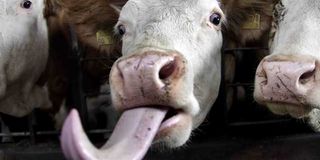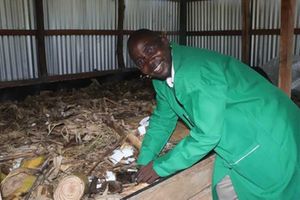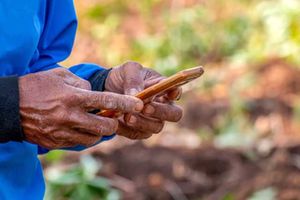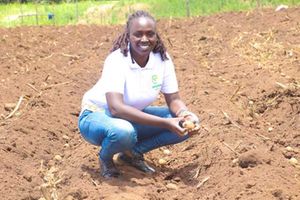
A dairy cow sticks out its tongue in a cowshed.
Why would a cow that has been healthy all along suddenly begin drooling? I’ve had that problem with my three-year-old cow for about three weeks.
Wairimu Njeri
Nakuru
Unhealthy conditions or deviations from normal health in cattle contribute to economic losses due to treatment costs, reduced production and possible deaths.
One such condition is excessive salivation or drooling in cattle, although this can be a sign of various issues including mouth problems, heat stress, certain (infectious) diseases, metabolic disorders or even emotional factors.
Mouth problems could include congenital abnormalities, infection causing mouth sores and drooling, foreign object/injury in the mouth, tongue or even abscess/blockage of salivary glands.
Cattle can also develop habitual drooling when under continuous heat stress, depending on the severity.
Increased respiration rates with drooling is a biological function of animals for increasing loss of this heat.
A cow suspected to be abnormally drooling, especially if accompanied by other symptoms such as fever, mouth lesions or difficulty eating/chewing, should be isolated to stop the spread of potential infections. It should then be provided with adequate care, including plenty of fresh water and feed, and a veterinarian should be contacted determine if there is anything wrong with the animal.
Felix Akatch Opinya,
Livestock production adviser
Growing grapes in Kakamega County
I would like your advice on growing grapes in Kakamega County? Is the weather and soil favourable? What do I need to do for good harvests? I have three acres in Matungu Constituency.
Oliver Washikomere
Thank you Oliver for your question. Grapes will do well in Kakamega. Consider the following factors.
Ecological requirements: Grapes do well in warm to hot climates. Fruit formation requires dry and sunny conditions. Fruit ripening requires warm temperatures to increase the sugar content and reduce acidity in the fruits.
Grapes can do well in a wide range of soils as long as they are deep, well drained and with a pH of 6.5-7.5.
Grapes do not tolerate salinity as it lowers growth and yields. Irrigation should be practised in areas with insufficient rain – about 500mm of water during the growing period. The growing season is September to March. Irrigation should stop after the long rains so that the crop can be dormant.
Fruit buds are formed in August to September and the plants should be well-maintained during this time.
Varieties: Grapes are classified as table grapes and wine grapes. The most common table grapes in Kenya are Dodrilabi, Black Rose, Italia, Muscat of Hamburg, Alphonse, Laralle, Muscat of Alexandria, Perletta, Cardinal and Dalbiki. Wine grapes include French Colombard, Sauzao, Saungnok Blank, Carbaret, Alicarte, Grenard and Semillon. Grapes are available in three colours – green, red and black.
Land preparation: The land should be thoroughly prepared by deep ploughing, followed by harrowing and the removal of all crop debris and weeds. It is advisable to carry out a soil test to assess for any nutrients deficiency. Apply well decomposed farmyard or compost manure.
Propagation: Grapes are propagated from hardwood cuttings. They can also be propagated through seeds, grafting, layering and budding. Spacing is 2m between seedlings and 3m between rows. Irrigation should be practised during the dry season or in areas with little rain. Drip irrigation is the best.
Fertiliser: Apply well decomposed farmyard manure at a rate of 20-30 tonnes per acre during land preparation.
Training: Grape vines should be trained. The first pruning is around April and May to get the new vegetative growth during the long rains, while the second pruning should be done around October and November.
Pests and diseases: Like any other crop, grapes are attacked by pests and diseases. The most common pests are thrips, flea beetles, leaf hoppers and mealybugs, while diseases include anthracnose and downey mildew. Make sure you control pests and diseases using the appropriate chemicals. If possible use biopesticides.
Harvesting: The first yields are expected four years after planting. The season of harvesting varies from one area to another and from one variety to another. Bunches with 18 percent Brix (sugar content) are the ones to be harvested.
Market: There is a ready local market for table grapes in supermarkets and streets throughout the year. Wine grapes can be sold to companies that make wine.
However, you should know the variety the wine makers want. Remember that the demand for grapes will differ, depending on the variety. Do some market research on the variety before you venture in grape farming. The demand for grapes is high, therefore market is not a challenge.
Value addition: Grapes are used to make wine, juice, jam, jelly, vinegar, raisins, grape seed oil and grape seed extracts.
Carol Mutua
Crop Production Specialist











